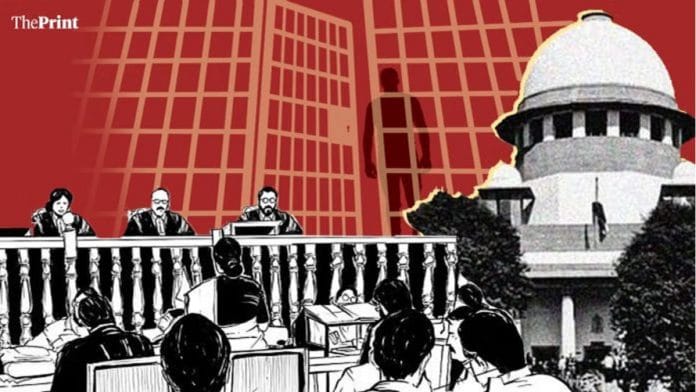New Delhi: In 2024, high courts across the country disposed of death penalty cases without seeking reports pertaining to the accused’s mental health, life circumstances, and jail conduct in all but 12 cases, said the ninth edition of ‘Death Penalty in India: Annual Statistics Report 2024’, published by Project 39A, a criminal justice research and legal aid programme at National Law University, Delhi.
Significantly, the year also saw a jump in confirmation of death sentences at the high court level, even as the Supreme Court did not confirm a single death sentence for the second consecutive year.
“High courts across the country confirmed death sentences for 9 prisoners in 9 cases and commuted the sentences of 79 prisoners in 53 cases,” the report added.
Significantly, a majority of the death sentences—139 to be precise—were handed out by trial courts, the report states. “Trial courts contributed to these high figures by imposing 139 death sentences in 2024.”
Notably, however, all except four death sentences were imposed without compliance with the Supreme Court’s guidelines on death penalty sentencing laid down in Manoj v. State of Madhya Pradesh in May 2022.
While trial courts imposed a higher-than-average rate of death sentences (139 death sentences), no information about the accused (including reports on their psychiatric evaluations, jail conduct, and life circumstances) was sought or relied upon in at least 90.5 percent of all death sentences.
What was the 2022 ruling?
In its landmark 20 May 2022 ruling in Manoj v. State of Madhya Pradesh, the Supreme Court highlighted the importance of considering the rehabilitation of the accused in capital punishment cases while laying down guidelines for trial courts’ collection of mitigating factors.
Stating that courts must evaluate a host of factors while handing capital punishment, such as a convict’s conduct in jail, along with their psychological and psychiatric evaluation reports to consider the possibility of reform, the court had ruled: “Mitigating factors in general, rather than excuse or validate the crime of committed, seek to explain the surrounding circumstances of the criminal to enable the judge to decide between the death penalty or life imprisonment.”
The convict’s social background, age, educational level, any trauma they may have experienced in their life, and family circumstances should also be taken into account, a three-judge bench led by then CJI U.U. Lalit had stated.
The report also mentioned that the high courts, similar to practices at the trial courts, sought information about the accused in only 19.40 percent of all death penalty cases where sentencing took place.
What did data reveal about Supreme Court?
The Supreme Court heard and decided five death penalty criminal appeals, involving five prisoners, in 2024, commuting the death sentences of four persons and acquitting one prisoner of all charges.
The court also heard one review petition involving two prisoners and commuted or reduced their death sentences.
Notably, the top court, for the fourth consecutive year, “did not confirm any death sentence in 2024, carrying forward this trend from 2023,” the report added.
In the reasons provided for the commutations, it relied on reports on mitigation factors, including the accused’s life history, jail conduct, and psychiatric evaluations. This demonstrates the continuation of the SC’s objective of gathering information about the accused while considering sentences in death penalty cases since 2021, the report stated.
However, the Supreme Court imposed life imprisonment without the possibility of release for 3 out of 4 prisoners without providing any reasons for choosing this sentence over life imprisonment with remission, the report mentioned.
What is life imprisonment without release?
A judicial creation of the Supreme Court in the Swami Shraddhananda ruling (2008), which was subsequently affirmed by a five-judge or Constitution bench in the Union of India v. Sriharan (2015) case, LWOR (life imprisonment without the possibility of release) sentences also dominated commutations at the high court-level in 2024.
“While commuting death sentences, the high courts have increasingly turned to the use of LWOR sentences, with high courts imposing LWOR sentences in the majority of commutations since 2020. This year, 61.14 percent of all commutations resulted in an LWOR sentence.”
Essentially, high courts heavily turned to these kinds of sentences, as can be gathered from the report.
Last year also saw the highest number of people living under sentence of death since the turn of the century, with 564 prisoners on death row at the end of the year.
“This reflects a continuing and unabated increase in the death row population, with a 41 percent increase since the compilation of the Annual Statistics Report in 2016,” the report stated, adding that this figure was heavily contributed to by trial courts.
Disparity between trends by HCs & SC
Significantly, the year also witnessed an increase in confirmation of death sentences at the high court-level, even as the Supreme Court did not confirm a single death sentence for the second consecutive year.
High courts confirmed death sentences for 9 prisoners in 9 cases and commuted the sentences of 79 prisoners in 53 cases.
While commutations dominated case outcomes at the high courts, 2024 marked the highest number of death sentence confirmations by high courts in a single calendar year since 2019.
(Edited by Radifah Kabir)
Also Read: One does not have to be an atheist to be an independent judge, ex-CJI Chandrachud tells BBC






